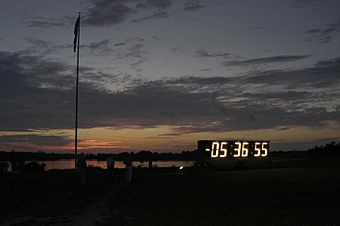Launch Complex 39 Press Site facts for kids
Quick facts for kids |
|
|
LC-39 Press Site–Clock and Flag Pole
|
|

The flagpole and countdown clock at dawn before the STS-114 launch in July 2005
|
|
| Location | Kennedy Space Center Merritt Island, Florida |
|---|---|
| Nearest city | Titusville, Florida |
| Built | 1967 |
| Visitation | not open to the public (n/a) |
| MPS | John F. Kennedy Space Center MPS |
| NRHP reference No. | 99001637 |
| Added to NRHP | January 21, 2000 |
The Launch Complex 39 Press Site is a special place at Launch Complex 39 in Merritt Island, Florida. It's where reporters and photographers gather to watch and report on space launches. Since the Apollo 8 mission in 1968, every U.S. space launch with astronauts on board has been seen from here.
This site is located near the Vehicle Assembly Building (VAB). It's about 3 miles (4.8 km) west and a bit south of Pad A, and 3.4 miles (5.4 km) southwest of Pad B.
The Press Site has a raised area with buildings for news organizations. It includes the main KSC News Center and other smaller support buildings. The News Center is about 8,700 square feet (808 square meters) and has 15 offices, work areas for reporters, and a media library. Some of the news groups with buildings there include CBS, NBC, Florida Today, The Orlando Sentinel, The Associated Press, and Reuters.
There's also a 100-seat auditorium in a separate building. This is where news conferences are held before and after launches. It's named after John Holliman, a former CNN reporter who covered space until he passed away in 1998. This building was built in 1980.
A large, bright digital countdown clock and a flagpole with an American flag are famous sights at the Press Site. They are often shown on TV during launch coverage. Before a launch, the clock counts down the time remaining until liftoff. After the launch, it counts forward to show how much time has passed since the rocket took off. During the last years of the Space Shuttle Program, a smaller flag showing the Space Shuttle Orbiter was flown below the American flag on launch day.
A Look Back: History of the Press Site
The Press Site was ready for its first launch coverage on November 9, 1967. This was for the Apollo 4 mission, which was an uncrewed flight. NASA received 510 requests from news groups to cover this event. The sound of the Saturn V rocket taking off was so powerful that CBS anchor Walter Cronkite famously said, "Our building's shaking here...the floor is shaking...this big glass window is shaking, we're holding it with our hands!" A few ceiling tiles even fell!
During the Apollo program, the main NASA news center was in Cocoa Beach. To have offices right at the launch site, a special dome building was moved to the Press Site in 1976. This dome was replaced by a bigger one in 1983. Finally, the current KSC News Center, a permanent building, opened in December 1995.
For the first ten years of Space Shuttle launches, companies that worked with NASA provided information to reporters from a place called the Joint Industry Press Center (JIPC). This was in a temporary trailer near a large covered grandstand that faced the launch pads.
The grandstand was built in 1967. However, it was badly damaged by Hurricane Frances in September 2004 and had to be taken down. Several other media trailers and buildings at the site were also damaged. They were either removed or replaced with new, ready-made structures.
On November 10, 2014, NASA turned on the famous countdown clock one last time for a test. The old clock was then removed and replaced. You can now see the old clock on display at the KSC Visitor Complex.
Reporters at the Launches
On July 16, 1969, a huge number of reporters came to the Press Site. There were 3,493 journalists from the U.S. and 55 other countries to watch the launch of Apollo 11. In 1975, a plaque was placed at the site by Sigma Delta Chi, a society for professional journalists. It calls the site an Historic Site in Journalism because it hosted "the largest corps of newsmen in history...to report fully and freely to the largest audience in history."
After Apollo 11, fewer reporters came to launches. But attendance went up again for Apollo 17, the last mission to the Moon and the only one launched at night. The Apollo-Soyuz Test Project launch in 1975 also brought many reporters.
The launch of STS-1 on April 12, 1981, had 2,707 accredited reporters. The second-highest number, 2,468, was for the STS-26 launch on September 29, 1988. However, many reporters watched this launch from a different viewing area. This was because the Press Site had limited access after the 1986 Challenger explosion for safety reasons. This restriction was later removed for future launches. Reporter attendance also increased in October 1998 for John Glenn's launch aboard STS-95. For the very last shuttle launch, STS-135, on July 8, 2011, 1,585 news people were there.
A Place of History
On July 16, 1974, a crowd gathered at the Press Site to officially name the entire launch complex a National Historic Site. This happened exactly five years after the Apollo 11 liftoff. Astronauts Neil Armstrong, Buzz Aldrin, and Mike Collins then showed a plaque to remember their famous flight.
Later, on January 21, 2000, the "LC-39 Press Site–Clock and Flag Pole" were specifically added to the U.S. National Register of Historic Places. This means they are recognized as important historical landmarks.
![]() This article incorporates public domain material from websites or documents of the National Aeronautics and Space Administration.
This article incorporates public domain material from websites or documents of the National Aeronautics and Space Administration.


